As noted before, “farm fresh” is often an oxymoron. Things found in barns are usually anything but fresh. Today’s example, a number of old feed sacks — burlap feed sacks, to be precise.

While the graphics can be real beauties, they lie beneath layers & clumps of stuff that is not so beautiful and smells — like dirt and, yes, manure.
In order to be of any real value, the vintage and antique feed sacks must be cleaned.
But it is neither safe nor advisable to throw them into the wash machine. (Since the weave of burlap sacks is so wide, I rarely ever trust my washing machine with them. Even the gentle or hand-wash settings always seems to create pulls or holes, often starting at the threads at the seams. I just don’t like to risk it.)
Instead, you must hand wash them — and, due to their size, one at a time at that.
While the old feed sacks I cleaned today are made of burlap, you can clean other feed, seed, flour, sugar sacks etc. in the same way.
How To Clean Old Feed, Flour, Seed Sacks Found In Barns
Step One: Remove Stuff From The Inside
As these old seed and feed sacks once held product (and also may have been used for lots of other purposes) there’s always some icky stuff left inside the sack. Stick your hand into the bottom of the sack and turn it inside-out. Shake it gently to remove any leftover contents. And then follow-up by using your hand (preferably gloved!) to wipe away anything hiding along the seams of the sack.
Once satisfied that you’ve removed everything, stick your hand in again and pull upwards to return the sack right-side-out, so that the graphics are again on the outside.
Step Two: Remove The Clumps Of Dirt & Animal Poo
I prefer to begin by hanging the sacks on the clothing line outside and using the hose to spray off the clumps and first layer or two of dirt; however, as it is below zero today (and not likely to change any time soon!), I begin with the bathtub. So gather your plastic cleaning gloves and follow me into the bathroom…
As soon as I start the warm water running in the bathtub, I take a single feed sack out and begin by holding in beneath the running water. I do not plug the tub yet as because many of the clods of dirt an manure will require pressure to come off. Since we are without the pressure of our handy lawn hose today, the pressure of the running water from the tap will have to do. Once the majority of the big pieces are off, I set the wet feed sack on an old towel while I wash the mud and farm fresh dirty pieces down the drain — being careful to catch any twigs, rocks, or other large pieces I do not want to pass into the drain and clog it. I toss the twigs and other pieces in the trash and rinse the tub a bit so that it is clean enough not to turn the running water brown right away.
Step Three: Soak & Rinse
Next, I put the stopper in the bathtub and begin filling the tub with warm water. As these sacks are pretty dirty, I only use warm water at this point.
Since old feed & seed sacks are quite large, you’ll need to fill the entire bottom of the tub with at least 2 inches of warm water. I lay the feed sack onto the water & push to submerge it. (Despite the earlier soaking, you’ll often find large sections of the sack are not wet. Sometimes this is where large pieces of dirt were; other times, it’s from the graphics themselves or other chemicals preventing the water from penetrating the textile fibers.)
Usually the water turns instantly brown again, but I continue to swish the sack gently around in the water to dislodge more dirt.
I don’t use any brushes or tools. Just my hands, the water, and, as necessary, gently rub the fabric against itself to dislodge things I can see and feel through the gloves. Remember, burlap is an especially rough textile and may contain “knots” and other natural bumps, so look before you spend time rubbing something that won’t come out. (Or at least won’t be removed without ruining the piece!)
As you swish and rub, look for holes, spots, etc. Avoid unnecessarily pulling on the holes and tears while working to remove the spots.
Typically, I repeat this step at least two more times so that the water bears just a slight tint of brown and few, if any, clumps of stuff. Then I proceed to flip the sack inside-out again, and give the inside a rinse.You’d be surprised how much remains on the inside, even after three rinsings!
If that is clean enough to not require repeating, I flip the sack back so that the graphics are outside and give it one final rinse.
Now, finally, it is time to proceed to washing with soap. This sack is on it’s fourth rinsing and just about ready for Step Four.
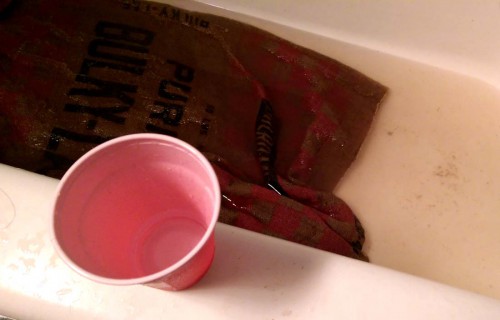
Step Four: Wash With Soap
With more warm water running into your clean enough for this (but not clean enough for your family) bathtub, plug the bathtub drain and add some gentle cleaner. I prefer to use, again, Murphy’s Oil Soap. I find it strong enough to clean, but not too drying for such old fabrics. (Old textiles left in barns like this can be more brittle than you imagine!) Also, since Murphy’s doesn’t make a lot of bubbles, you can see what you are doing. And you’ll want to see what you are doing so you can address spots. (I know a lot of you are thinking you need bleach to clean something this filthy, but scrubbing and rubbing does more to really clean than soaking in bleach or other chemicals — and I do not want to discolor or otherwise damage such old fabrics!)
Bonus: Murphy’s Oil leaves a more natural and non-offensive scent, which means the cleaned primitive farm advertising piece is much more like it should be — and isn’t now a perfumed piece that annoys those looking for primitive items or mantiques.
Once you add your previously-rinsed old seed or feed sack to the soapy water, you’re likely to see much more of the brown than you’d imagined could possibly be left. You can let the submerged textile soak a bit in the soapy water, if you’d like. And then come back and gently swish it around and rub spots as necessary.
Step Five: Rinse
As the tub drains its filthy water, I run the tap with warm water again and rinse out the sack.
Step Six: Drying
Once you are satisfied with how clean it is, you can remove the old farm advertising sack from the water and gently wring it to remove the excess water. Once you’ve got as much water out as you can from wringing it, lay it flat on a large beach or bath towel and roll it up so that the towel can absorb more of the water. You may have to do this more than once, with a new clean & dry towel each time, as these large old feed and seed sacks can hold a lot of water.
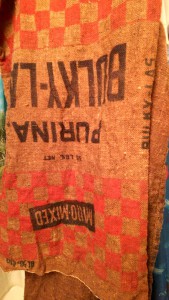 Then hang the old seed sacks to dry. (Antique & vintage textiles are never a good mix with dryers.) Again, this is great to do out on the clothesline, but the season prevents that. So I hang them to dry on clothes hangers with clips (with plastic, vinyl, or rubber tips to avoid rusting!) over the bathtub. It is best to hang the seed sacks from the bottoms, where they are stitched, so that the heaviest part of the bags are at the top and not pulling so much on the rest of the fabric. I like to use the tired hangers for this, so that I have more room to work on cleaning up the bathtub (again!) while things dry. However, if you have different fabrics and colors involved, you may wish to hang each piece separately so that there is no color transfer, bleeding, or discoloration. (This set lets you have the option to hang tiered or use the hangers individually.)
Then hang the old seed sacks to dry. (Antique & vintage textiles are never a good mix with dryers.) Again, this is great to do out on the clothesline, but the season prevents that. So I hang them to dry on clothes hangers with clips (with plastic, vinyl, or rubber tips to avoid rusting!) over the bathtub. It is best to hang the seed sacks from the bottoms, where they are stitched, so that the heaviest part of the bags are at the top and not pulling so much on the rest of the fabric. I like to use the tired hangers for this, so that I have more room to work on cleaning up the bathtub (again!) while things dry. However, if you have different fabrics and colors involved, you may wish to hang each piece separately so that there is no color transfer, bleeding, or discoloration. (This set lets you have the option to hang tiered or use the hangers individually.)
Step Seven: Inspection
Once the feed sacks are dry, inspect them again for holes, spots, and other imperfections
Sadly, after all this work, there sometimes are spots left. You can wash them again, as needed.
Sometimes I still find a few seeds that have worked their way into the seams and fabric weave as well.
As a buyer or collector, you likely will need to wash your new acquisition again. Even when dealers like myself clean the items, it’s more for presentation than the final act; we know items will be handled in the shop and we remove the “ick factor” but other shoppers do handle the items, including laying them on the floor to inspect them and the like. So whatever textile you buy, you ought to be prepared to launder it yourself for use or display in your own home.
It is especially important to note any holes, tears, or weak spots before you ever even consider using the washing machine.
Final Notes
As a dealer, I never mend any sacks as that would mean the piece is not in original or as found conditions. Other than filth, I leave them as original as I can and instead price accordingly. I leave it for the buyer to decide what, if anything, they want to fix. (Sometimes, they like the authentic nature of the sacks as they are. Sometimes they prefer to stitch them up a bit before displaying them or using them for pillow cases, foot stool coverings, etc. But that is up to the buyer.)
With finer gunny sacks, or sacks with lighter colors and finer weaves, you may need to do some additional cleaning on spots. More on that at a later date as my back is sore from all that time bent over the tub!
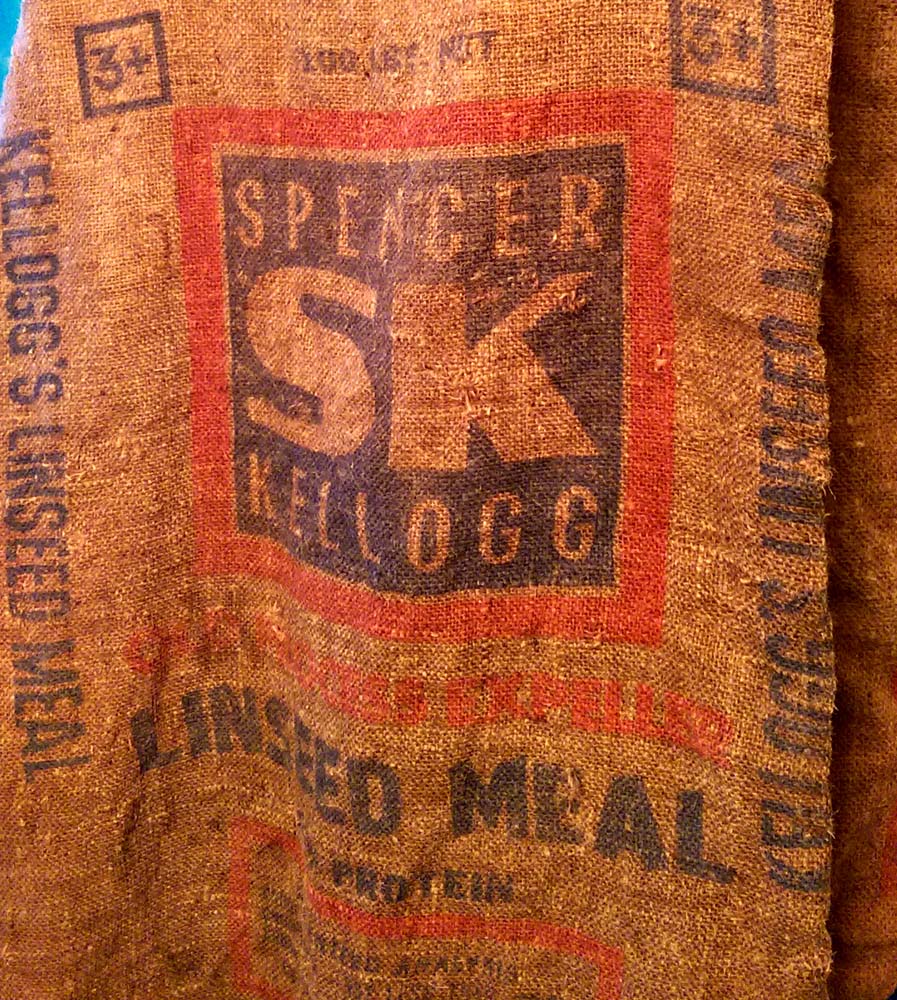
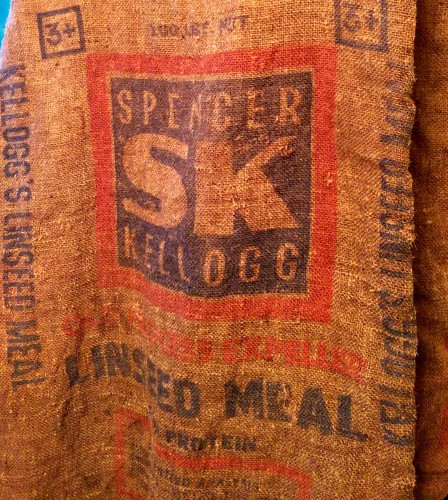
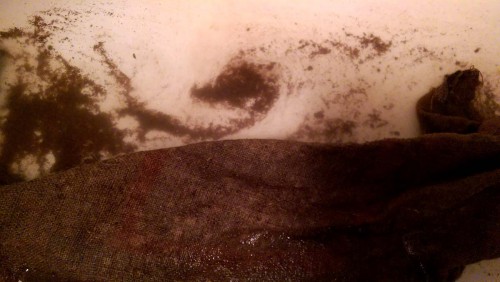
Leave a Reply